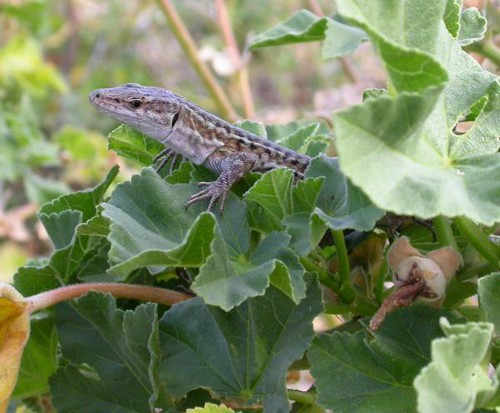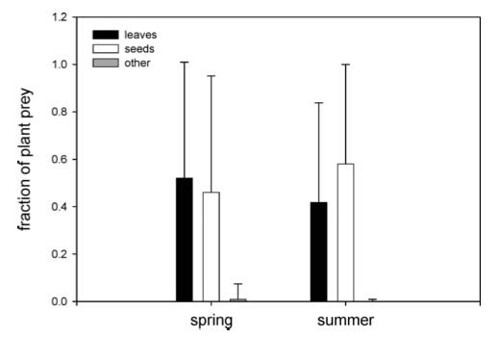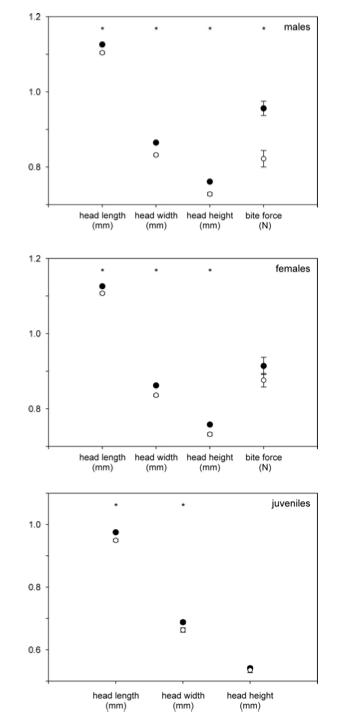tags: researchblogging.org, evolution, speciation, Pod Mrcaru lizard, Podarcis sicula, reptiles
Evolution has long been thought to occur slowly, due to small and gradual genetic changes that accumulate over millions of years until eventually, a new species arises. However, recent research has been calling this assumption into question. According to a study that was just published by an international team of scientists, dramatic physical changes can occur very rapidly -- on the order of just 30 generations in this case.
To document adaptation and evolution, a group of researchers moved a small group of lizards from their original island home island to a nearby island in 1971. Just five male and five female Italian wall lizards, Podarcis sicula, were translocated from the islet of Pod Kopiste to the nearby islet of Pod Mrcaru, both of which belong to Croatia and are located in the southern Adriatic Sea.
Thirty-six years later, after the Croatian war ended, another team of scientists finally returned to the island to check on the reptilian translocations and were surprised to find that the island was teeming with their descendants. This team was led by Duncan Irschick, biology professor at the University of Massachusetts, Amherst, and included Anthony Herrel of Harvard University and the University of Antwerp, Kathleen Huyghe, Bieke Vanhooydonck, Thierry Backeljau and Raoul Van Damme of the University of Antwerp, Karin Breugelmans of the Royal Belgian Institute of Natural Sciences and Irena Grbac of the Croatian Natural History Museum.
To determine whether these lizards were the same species as the parental population, the team analyzed two mitochondrial DNA fragments and found that the parental and translocated lizard populations were genetically indistinguishable from each other.
Oddly, Pod Mrcaru's original lizard residents, Podarcis melisellensis, were nowhere to be found.
"The new habitat once had its own healthy population of lizards, which were less aggressive than the new implants," reports Irschick, senior author of the paper that was published in recently in The Proceedings of the National Academy of Sciences.
"The new species wiped out the indigenous lizard populations, although how it happened is unknown."
The translocated lizards diet changed. The parental population of lizards on the barren island of Pod Kopiste are very active because they pursue insects. But the islet of Pod Mrcaru, where the lizards were translocated, has an abundance of plants. The team discovered that the descendants of the translocated lizards were mainly consuming plants;
Figure 1: Graphs illustrating differences in diet between populations in spring
(A) and summer (B). Differences in the proportions of plants (black bars), invertebrate prey (white), and rest fraction (gray) are highly significant between populations. Seasonal differences in diet were highly significant on Pod Mrcaru but not on Pod Kopiste. Error bars depict 1 standard deviation. [larger view].
This increase in plants in the translocated lizards' diet is dramatic when compared to the diet of the parental population on Pod Kopiste, which is comprised almost exclusively of insects. Further, analysis of the translocated lizards' stomach contents showed that their diet consisted of as much as two-thirds vegetable matter, depending on the season;
Figure 2: Bar graph illustrating the fraction of plant prey in the diet of lizards from Pod Mrcaru consisting of leaves (black), seeds (white), and other plant material (gray). Fibrous, indigestible materials such as leaves compose a large fraction of the diet in both spring and summer. Error bars depict 1 standard deviation. [larger view].
Because the descendants of the translocated lizards were eating such a radically different diet, the team collected morphometric data on these animals to determine of their bodies had changed to meet the demands of this new diet. It had: the team found that these lizards have taller, longer and wider heads and, predictably, a correspondingly increased bite force;
Figure 3: Graphs illustrating differences in aspects of head morphology and bite force for male (Top), female (Middle), and juvenile (Bottom) lizards from two populations (filled symbols, Pod Mrcaru; open symbols, Pod Kopiste) having diverged for 36 years. On the graphs, the size-adjusted means are represented, thus illustrating body-size-independent variation in morphology and bite force. Population differences are highly significant and show how lizards on Pod Mrcaru generally have bigger heads and greater bite forces. The y axis gives the log10-transformed size-adjusted head dimensions and bite force. Error bars depict 1 standard deviation. Asterisks depict significant differences between populations.
In short; these measured changes in head morphology resulted from the translocated lizards' adaptation to a different food source; plants.
"As a result, individuals on Pod Mrcaru have heads that are longer, wider and taller than those on Pod Kopiste, which translates into a big increase in bite force," observes Irschick. "Because plants are tough and fibrous, high bite forces allow the lizards to crop smaller pieces from plants, which can help them break down the indigestible cell walls."
These lizards' physical changes also included the unexpected presence of a special subset of muscles in the intestines, known as caecal valves. These valves, which slow the movement of food by creating fermenting chambers in the gut, is the most dramatic morphological change shown by these lizards;
Figure 4: Photographs illustrating the cecal valves in a male (A), a female (B), and a hatchling (C) P. sicula from Pod Mrcaru. Note the thick cecal wall and pronounced ridges. The arrow in C indicates the position of the cecal valve in a hatchling as seen from the outside.
In contrast, less than 1% of all lizard species have caecal valves in their intestines.
Intestinal fermenting chambers provide a home for microorganisms that break down cellulose into volatile fatty acids that the lizards can utilize, so these chambers are only present in animals that consume plants. Additionally, the researchers also found that the hindguts of the translocated lizards contained nematodes, whereas they were absent from the hindguts of the parental population.
"Striking differences in head size and shape, increased bite strength and the development of new structures in the lizard's digestive tracts were noted after only 36 years, which is an extremely short time scale," said Irschick.
But the changes were not limited to morphology; the translocated lizards also showed distinct differences in their social behavior and natural history. Because abundant plants provide a more predictable and easily available food supply, the lizards became slower-moving browsers instead of actively chasing prey. Further, they became less aggressive towards others of their own kind; thus, their population reached a higher density than on their original island home and they no longer defended a territory.
"What is unique about this finding is that rapid evolution can affect not only the structure and function of a species, but also influence behavioral ecology and natural history," concludes Irschick.
Sources:
Herrel, A., Huyghe, K., Vanhooydonck, B., Backeljau, T., Breugelmans, K., Grbac, I., Van Damme, R., Irschick, D.J. (2008). Rapid large-scale evolutionary divergence in morphology and performance associated with exploitation of a different dietary resource. Proceedings of the National Academy of Sciences, 105(12), 4792-4795. DOI: 10.1073/pnas.0711998105
UMass Amherst press release (quotes).






It is possible this is just morphological and behavioral plasticity present in the parent population but not expressed at home. I have not seen any argument for change in the genetic make-up of the population. My definition of evolution is change in genetic makeup of a population, not just change in morphology or behavior. I would guess there has been genetic change, but I've not seen any documentation.
"I have not seen any argument for change in the genetic make-up of the population" - Jim Thomerson
Well they only analysed mitochondrial DNA to confirm ancestry of the source population.
Such a morphological and phsyiological plasticity would be unlikely to just exist in a dormant manner in the original population. It takes resources to maintain redundant genetic systems.
Clearly further genomic and karyotypic work needs to be carried out but it is unlikely to be merely a case of re-awakening dormant physiological plasticity.